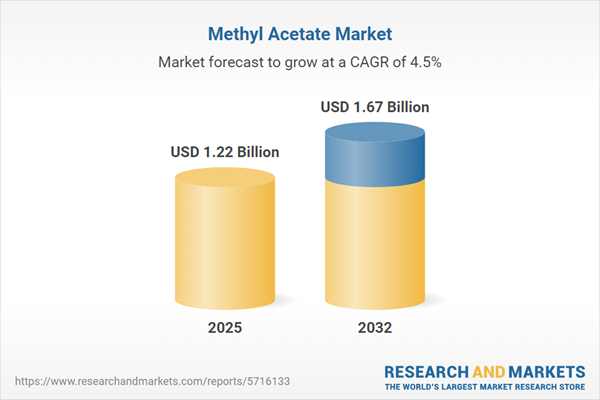Speak directly to the analyst to clarify any post sales queries you may have.
Senior decision-makers in the chemical sector are re-evaluating methyl acetate’s role within sustainable supply chains. Its versatility and alignment with stricter environmental standards are reshaping sourcing and operational approaches across industrial applications. Forward-thinking leaders now view methyl acetate as pivotal in adapting to evolving compliance landscapes and achieving broader sustainability goals.
Methyl Acetate Market Snapshot
The methyl acetate market is charting consistent growth, with market size reaching USD 1.17 billion in 2024 and projected expansion to USD 1.22 billion in 2025. This steady rise, underpinned by a 4.50% CAGR, positions the market to attain USD 1.67 billion by 2032. These developments are fostered by greater demand for low-toxicity, rapid-evaporation solvents. With stakeholders emphasizing reliability and greener alternatives, the market is characterized by strong adoption in sectors prioritizing operational safety and sustainability. Regulatory updates, technical enhancements, and supply chain resilience continue to influence business priorities throughout the value chain.
Methyl Acetate Market Scope & Segmentation
This research provides detailed insight for executives and procurement leaders into market dynamics and actionable opportunities along the methyl acetate value chain:
- Application Segments: Methyl acetate is widely used in adhesives and sealants, as a key chemical intermediate, in cleaning and degreasing processes, for paints and coatings, and in pharmaceuticals—supporting critical operations in manufacturing, automotive, electronics, and healthcare.
- End Use Industries: Its use enhances efficiency, product quality, and regulatory compliance across the automotive, electronics, pharmaceutical, and printing industries. Each relies on consistent supply and meeting high compliance standards.
- Grade Types: Available in electronic, industrial, and reagent grades, methyl acetate meets specific quality and performance benchmarks required for specialized manufacturing and scientific research.
- Distribution Channels: Market access is provided through direct sales, distributor networks, and online B2B platforms, offering procurement flexibility for both international buyers and local industry clusters.
- Regional Coverage: The market spans the Americas, Europe, Middle East and Africa, and Asia-Pacific. Each region requires tailored sourcing strategies and regulatory compliance to address diverse infrastructure, supply networks, and market regulations.
- Technology Focus: Advances in catalysts, digital production monitoring, and broadening feedstock sources—including bio-based acetic acid and renewable methanol—drive process efficiency and support sustainability commitments.
- Company Profiles: The report covers leading producers such as Celanese Corporation, Eastman Chemical Company, The Dow Chemical Company, LyondellBasell Industries N.V., INEOS Group Limited, BASF SE, Saudi Basic Industries Corporation, Mitsubishi Chemical Corporation, LG Chem Ltd, and China Petroleum & Chemical Corporation. Their shifting strategies and roles are mapped to support leadership benchmarking.
Methyl Acetate Market: Key Takeaways for Decision-Makers
- Methyl acetate is increasingly selected due to its environmentally responsible profile and compatibility with shifting procurement strategies centered on compliance and sustainability mandates.
- Innovations in production, including advanced catalyst development and real-time monitoring, are supporting greater process optimization and energy management across operating environments.
- Adoption of renewable feedstocks is improving supply flexibility and is becoming central for enterprises pursuing circular economy initiatives and transparency throughout the chain of custody.
- Producer-end user collaboration enables refinements in product formulations, especially within adhesives, coatings, and life sciences segments where customization and fast adaptation are valued.
- Regional market dynamics reflect disparities in supply infrastructure, regulatory enforcement, and industry focus—directly affecting decision-making within electronics and industrial cleaning sectors.
- The acceleration of digital procurement channels is enhancing responsiveness for multinationals and specialized businesses, enabling swift adaptation as market and operational conditions evolve.
Tariff Impact: United States 2025 Measures
Forthcoming US tariff changes are set to influence methyl acetate trade, prompting a reassessment of sourcing and cost-management strategies. Companies may prioritize domestic suppliers or seek tariff-free supply routes. For pharmaceuticals, risk management protocols could mitigate immediate impact, while sectors such as industrial cleaning might find opportunities in supplier renegotiations and consideration of alternative materials. Proactive inventory and procurement planning will become essential for maintaining stable operations and managing cost pressures in this changing terrain.
Methodology & Data Sources
This research utilizes consultations with industry experts, comprehensive stakeholder surveys, and targeted secondary analysis. Data sources include regulatory briefs, public company disclosures, trade publications, and academic literature. Findings are validated through triangulation and scenario analysis to deliver actionable, reliable intelligence for senior leadership.
Why This Report Matters
- Empowers senior leaders to manage strategic risk and optimize portfolio decisions in response to evolving regulatory and tariff pressures affecting methyl acetate.
- Enables management to understand supply chain trends, price drivers, and sustainability opportunities, supporting robust long-term sourcing frameworks.
- Supports leadership in developing technology and supply strategies to meet emerging operational needs and market dynamics with confidence.
Conclusion
Methyl acetate is cementing its place in sustainable business strategies as regulatory benchmarks rise and efficient supply chain practices become pivotal. Executives leveraging these insights can drive operational agility and sustained growth.
Additional Product Information:
- Purchase of this report includes 1 year online access with quarterly updates.
- This report can be updated on request. Please contact our Customer Experience team using the Ask a Question widget on our website.
Table of Contents
3. Executive Summary
4. Market Overview
7. Cumulative Impact of Artificial Intelligence 2025
List of Figures
Samples

LOADING...
Companies Mentioned
The key companies profiled in this Methyl Acetate market report include:- Celanese Corporation
- Eastman Chemical Company
- The Dow Chemical Company
- LyondellBasell Industries N.V.
- INEOS Group Limited
- BASF SE
- Saudi Basic Industries Corporation
- Mitsubishi Chemical Corporation
- LG Chem Ltd
- China Petroleum & Chemical Corporation
Table Information
| Report Attribute | Details |
|---|---|
| No. of Pages | 189 |
| Published | October 2025 |
| Forecast Period | 2025 - 2032 |
| Estimated Market Value ( USD | $ 1.22 Billion |
| Forecasted Market Value ( USD | $ 1.67 Billion |
| Compound Annual Growth Rate | 4.5% |
| Regions Covered | Global |
| No. of Companies Mentioned | 11 |









